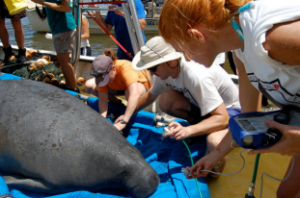
Researchers measure the health of a Florida manatee captured in Mobile Bay, AL before fitting it with a satellite tag. Photo credit: DISL
In Mobile Bay, two key species were at risk for contamination as oil entered the surrounding waters after the Deepwater Horizon disaster; the commercially important eastern oyster and the endangered West Indian manatee. These very different species were closely monitored to study effects of oil exposure not only because of their special interest throughout the northern Gulf, but because they represent two distinct habitat niches and life-styles typical of species in local waters (stationary bottom-dwelling residents and mobile ocean-going visitors).
Classroom Activity: Migrating Manatees
Some animals stay in one general area their entire life while others migrate, sometimes very long distances. Animals may migrate to another area to mate, find food, because of a change of season or other environmental or behavioral cues. Florida manatees spend the winter in Florida near the warmth of springs that remain at a constant temperature year round but during the warmer months travel long distances in search of aquatic plants to eat. In the US they travel as far west as Texas and as far north as Virginia.
Residents and Visitors of Mobile Bay_Oil Spill Impacts – PDF 1.4MB
